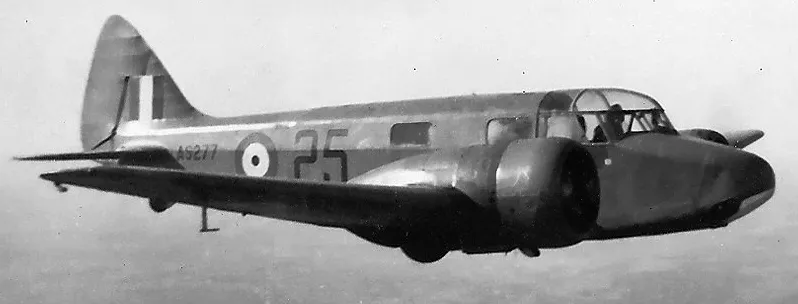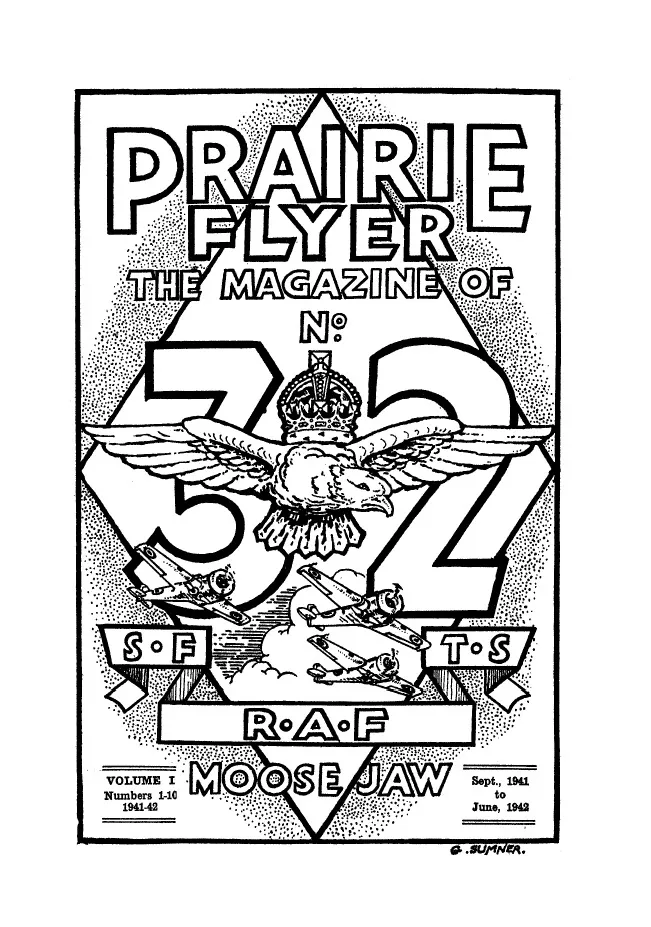Oxford serial: AS395
(Bob Brown Photo)(Source Harold A Skaarup Web Page)
Airspeed A.S. 10 Oxford Mk. II, RCAF (Serial No. AS277), 25, in flight over Saskatchewan, 1942.
The Airspeed AS.10 Oxford was a twin-engine monoplane aircraft developed and manufactured by Airspeed. It saw widespread use for training British Commonwealth aircrews in navigation, radio-operating, bombing and gunnery roles throughout the Second World War.
The Oxford was developed by Airspeed during the 1930s in response to a requirement for a capable trainer aircraft that conformed with Specification T.23/36, which had been issued by the British Air Ministry. Its basic design is derived from the company's earlier AS.6 Envoy, a commercial passenger aircraft. Performing its maiden flight on 19 June 1937, it was quickly put into production as part of a rapid expansion of the Royal Air Force (RAF) in anticipation of a large-scale conflict.
As a consequence of the outbreak of war, many thousands of Oxfords were ordered by Britain and its allies, including Australia, Canada, France, New Zealand, Poland, and the United States. Following the end of the conflict, the Oxford continued to achieve export sales for some time, equipping the newly formed air forces of Egypt, India, Israel, and Yugoslavia. It was considered to be a capable trainer aircraft throughout the conflict, as well as being used a general-purpose type. A large number of Oxfords have been preserved on static display.
Wikipedia
 Oxford Trainer
Oxford Trainer
 Wikipedia Oxford Trainer
Wikipedia Oxford Trainer
 Harold A Skaarup Web Page
Harold A Skaarup Web Page
Aircraft Images
Oxford AS202
Oxford Mk. II AS202
Taken on strength at No. 2 Elementary Flying Training School at Fort William, Ontario. To No. 4 Training Command on 26 August 1941, for use by No. 34 Service Flying Training School at Medicine Hat, Alberta. Winter conversion kit installed at this School by 4 June 1942. To Aircraft Repair for overhaul, 27 October 1942 to 29 January 1943. To storage with No. 4 Training Command when completed, issued from storage on 25 March 1943. Crashed on 19 August 1943, while with No. 32 Service Flying Training School at Moose Jaw, Saskatchewan. Back to Aircraft Repair on 20 October 1943, but declared Category A and not repaired.
1941-07-16 Taken on Strength No. 2 Training Command
2019-08-20
1943-August-18 Accident: 32 Service Flying Training School Loc: Aerodrome Names: Cooke | Crouch | Daly
1943-10-21 Struck off Strength Struck off, reduced to spares and produce
2020-09-22
Oxford AS395
Oxford Mk. II AS395
Taken on strength at No. 2 Elementary Flying Training School at Fort William, Ontario. To No. 4 Training Command on 18 October 1941, for use by No. 37 Service Flying Training School at Calgary, Alberta. Winter conversion kit installed at No. 37 SFTS by 2 July 1942. To Aircraft Repair for overhaul, 14 March to 20 June 1943. Back to No. 4 Training Command when completed. Category A crash on 19 August 1943, while being operated by No. 32 Service Flying Training School at Moose Jaw, Saskatchewan. Scrapped at No. 32 SFTS.
1941-09-18 Taken on Strength No. 2 Training Command
2019-08-20
1943-August-18 Accident: 32 Service Flying Training School Loc: Aerodrome Names: Cooke | Crouch | Daly
1943-10-27 Struck off Strength Struck off, reduced to spares and produce
2019-08-20
Unit Desciption
32 SFTS (32 Service Flying Training School)
Graduates of the EFTS "learn-to-fly" program went on a Service Flying Training School (SFTS) for 16 weeks. For the first 8 weeks the trainee was part of an intermediate training squadron; for the next 6 weeks an advanced training squadron and for the final 2 weeks training was conducted at a Bombing & Gunnery School. The Service schools were military establishments run by the RCAF or the RAF.
There were two different types of Service Flying Training Schools. Trainees in the fighter pilot stream went to an SFTS like No. 14 Aylmer, where they trained in the North American Harvard or North American Yale. Trainees in the bomber, coastal or transport pilot stream went to an SFTS like No. 5 Brantford where they learned multi-engine technique in an Airspeed Oxford, Avro Anson or Cessna Crane.
SFTS31 NO32 SFTS Publication
For more Information on RCAF Station Moose Jaw see here
 RCAF.Info - RCAF Station Moose Jaw SK
RCAF.Info - RCAF Station Moose Jaw SK
 RCAF.Info - Relief Landing Field Buttress SK
RCAF.Info - Relief Landing Field Buttress SK
 RCAF.Info - Relief Landing Field Burdick SK
RCAF.Info - Relief Landing Field Burdick SK
 RCAF.Info - Relief Landing Field Caron SK
RCAF.Info - Relief Landing Field Caron SK
 YouTube - Abandoned Saskatchewan
YouTube - Abandoned Saskatchewan
Project 44 BCATP
 Project 44 BCATP
Project 44 BCATP
 YouTube - Valour Canada Aerodrome of Democracy
YouTube - Valour Canada Aerodrome of Democracy



